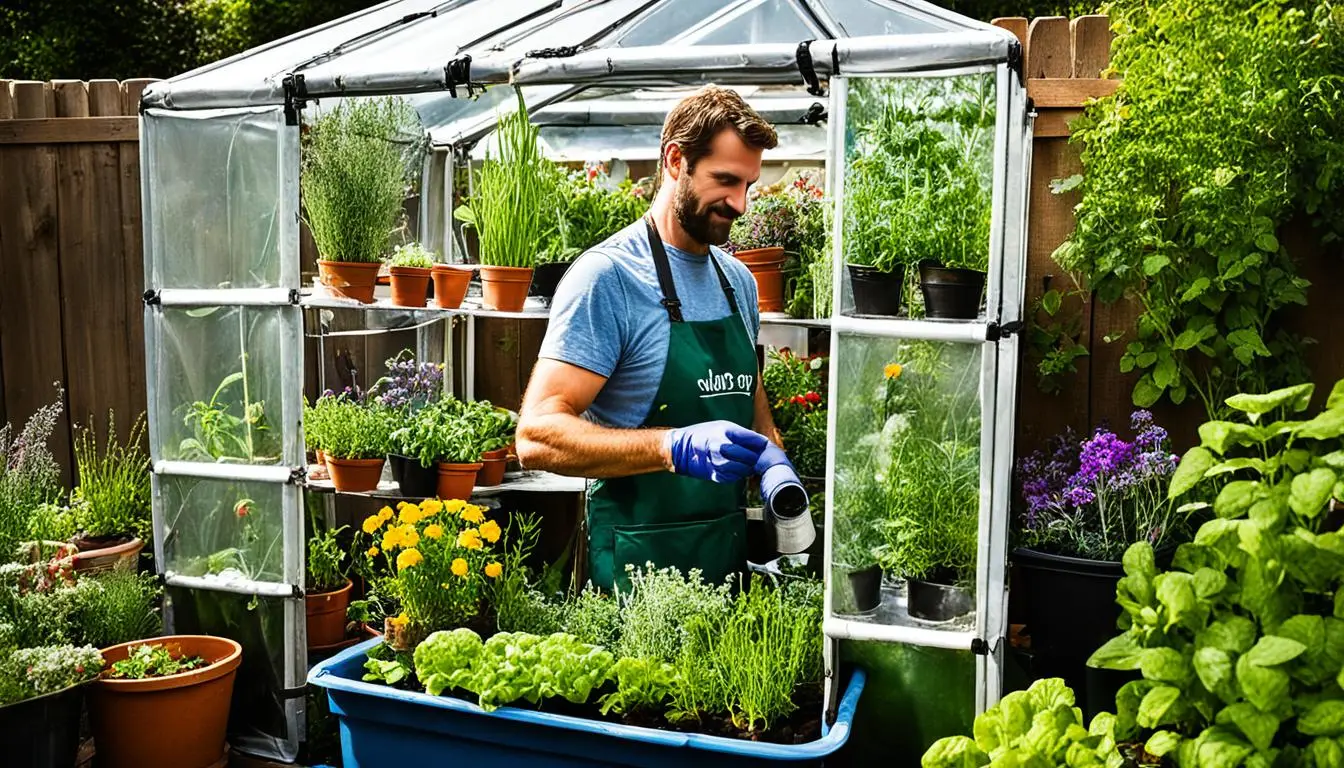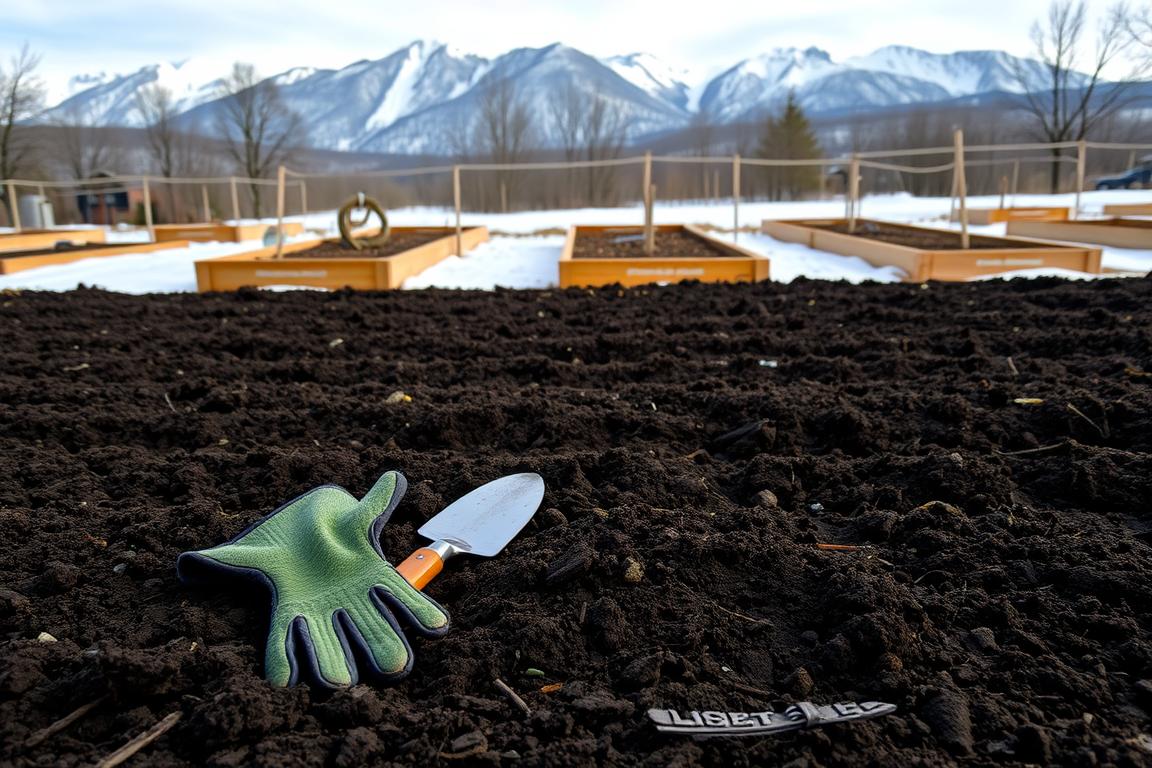Starting a garden doesn’t have to break the bank. The initial cost can seem high, with supplies and tools often over $1,000. But, investing in growing your own food pays off over time. It’s best to start with a small garden and grow from there.
Key Takeaways
- Start a new garden on a budget by beginning small and gradually expanding
- Utilize affordable and repurposed materials for raised beds and soil
- Invest in quality tools over time, starting with inexpensive options
- Forage for free or low-cost materials such as recycled items and hand-me-downs
- Design your garden with cost-effective solutions in mind, like upcycling furniture
Start Slow and Observe
Starting a garden on a budget means taking it slow and careful. Gardens can get costly at first, with set-up expenses hitting $1,000. But remember, you probably won’t harvest $1,000 of food in the first years.
Gardening Can Be Expensive Initially
At first, the cost to begin a garden can be high. But, if you start small and grow gradually, you can manage a fine garden without spending too much. The benefits of gardening show up slowly, so it’s wise to start slow and observe how your garden changes with time.
Grow Gradually and Learn as You Go
By starting small and growing gradually, you can get better at gardening. It helps with building a budget-friendly garden design, using smart gardening methods, and finding tips that save money. These ideas suit what your garden and your wallet need.
Patience is Key
When you start your garden, remember that patience matters a lot. Your gardening skills and how much your garden produces will get better over the years. So, it’s key to start slow, observe, and make gradual improvements. This way, you can build a garden that lasts and saves you money.
Save on Raised Beds
Starting a new garden often means dealing with high costs, especially for raised beds. A lot of money goes into using rot-resistant lumber, like cedar or redwood. This can be tough for gardeners on a budget. However, many budget-friendly alternatives for raised bed materials exist. They let you save money while keeping your garden design strong.
If you’re looking to spend less, try using cinderblocks, galvanized stock tanks, logs, pallets, and rocks. They are inexpensive raised bed materials that cut costs and look interesting in your garden. By seeking out thrifty gardening techniques, you can build your cost-effective gardening solutions. This can match your budget while giving your garden a unique style.
DIY Raised Bed Soil
Making your own DIY raised bed soil is a great money-saving method. Instead of buying bulk soil, create your own compost system. Then, use that compost in your garden beds. This way, you save money. You also have control over what’s in your soil. It’s a budget-friendly and sustainable gardening solution.
Yes, creating your own soil needs time and effort. Yet, it pays off in the end by saving you money. By using thrifty gardening techniques and making your DIY raised bed soil, you build a budget-friendly garden. This economical approach provides your plants with good, healthy soil.

Choose the Right Tools
Starting a garden with a limited budget means selecting your tools wisely. Begin with inexpensive or used tools. This helps you figure out the budget-friendly garden tools you actually need over time.
Start with Inexpensive Tools
Don’t buy expensive gardening equipment right off the bat. Choose cost-effective tools that can do the job. This way, you’ll understand which tools are best for your economical garden setup. When you’re ready, you can move onto better quality tools as your budget grows.
Invest in Quality Tools Over Time
Starting with inexpensive gardening equipment is clever. But, remember to upgrade to higher-quality tools as you go. Replace worn-out tools with budget-friendly garden tools that last. This way, you’re slowly creating a collection of thrifty gardening solutions as you gain more experience and money.
Forage for Materials
Starting a garden on a budget means looking for repurposed materials. You can find them in your backyard or around the community. This way, you can save money and be creative with your garden’s look.
Use Recycled or Repurposed Items
Items like rocks, wine bottles, and split firewood can help you make a beautiful garden. They are all budget-friendly gardening solutions. Be creative and use what you have in unique ways for your garden.
Ask Friends and Family for Useful Items
Ask those you know if they have any items for your garden. They may give you what they don’t need, saving you money. This adds a special touch to your garden and makes it more personal.

Starting a New Garden on a Budget
Starting a garden on a budget means choosing the right place. Look for an area with 6 hours of direct sun. This is key for your garden to grow well with cheap and efficient methods.
Choose the Right Location
Begin with a small garden, like 10×10 or 12×12 feet. It’s easy to manage and lets you grow over time. This way, you learn how to garden smartly without getting overwhelmed.
Start Small and Manageable
First, get rid of the sod. Cut it into strips and roll it away. This step saves money because you reuse the soil. Just add a 1-inch layer of compost to make your soil better for cheap gardening.
Remove and Reuse Sod
To keep weeds away, cover the area with a thick layer of mulch. You can use items like newspaper, leaves, or grass. This barrier stops weeds and keeps the soil moist.
Mulch to Prevent Weeds
Now, you can plant seeds or seedlings right into the soil. This method is cheap and effective. You won’t need to buy expensive beds or build complicated structures.
Plant Seeds or Transplants
Budget-Friendly Garden Design
Creating a beautiful garden doesn’t need to cost a lot. You can recycle and use what you have creatively. This makes your garden unique without spending too much.
Paint for Dramatic Effect
Change your garden’s look by painting a fence or shed brightly. A bold color like black behind your plants makes them stand out. This is a smart way to design your garden on a budget.
Plant Hanging Baskets
Hanging baskets are affordable and bring instant color to your garden. They’re perfect for growing small vegetables and herbs. Adding hanging baskets is an easy and cheap garden decoration idea.
Divide Perennials
You can spread your garden by splitting perennial plants. This lets you make new plants from your old ones for free. It’s a budget-friendly way to enhance your garden’s beauty.
Upcycle Furniture as Planters
Turn old furniture into planters to make your garden unique. Items like sinks and pallets make interesting garden features. It’s a creative, budget-friendly way to personalize your garden.
Conclusion
It’s fully doable to start a garden without spending a lot. Do it step by step, and you’ll get there. Pick low-cost materials for your garden, like using old items or things you find for free. With the right approach, your garden will flourish.
Stay patient and don’t mind a little work. By using the advice shared here, your garden will thrive. It’s about enjoying fresh food and lovely views without emptying your wallet. This method allows you to live comfortably while following your budget.
Starting a garden is more like a path you travel. You learn and improve every step of the way. Your garden will reflect your personal taste and be a place of beauty. Remember the journey, and your garden will turn into a wonderful, budget-friendly retreat.
FAQ
How can I start a new garden on a budget?
To start a garden on a budget, think small and use what you have. You can recycle and repurpose items. Also, pick up tools and supplies slowly. This way, you avoid overspending and grow your garden bit by bit.
What are some budget-friendly options for raised beds?
For raised beds, consider cinderblocks, stock tanks, logs, pallets, or rocks. Choose what fits your budget. Making your own compost can also save you a lot of money on soil.
How can I save money on gardening tools?
Kick off with cheap or secondhand tools. Figure out the essentials as you go. Then, swap out lower quality tools for better ones when you can afford to.
Where can I find free or low-cost materials for my garden?
Find garden materials that are free or low cost by looking to friends, family, or even your yard. Items like rocks and old bottles can add charm to your garden without the big spending.
What are some tips for starting a new garden on a budget?
Opt for a sunny spot and keep your first garden small, about 10×12 feet. Remove sod and add healthy soil, then mulch to keep weeds away. Finally, sow seeds or plant seedlings right in the ground.
How can I design an attractive garden on a budget?
To make your garden look great for less, try painting a fence or shed black for contrast. Also, use hanging baskets or divide perennial plants. Even old furniture can become fun plant holders.






